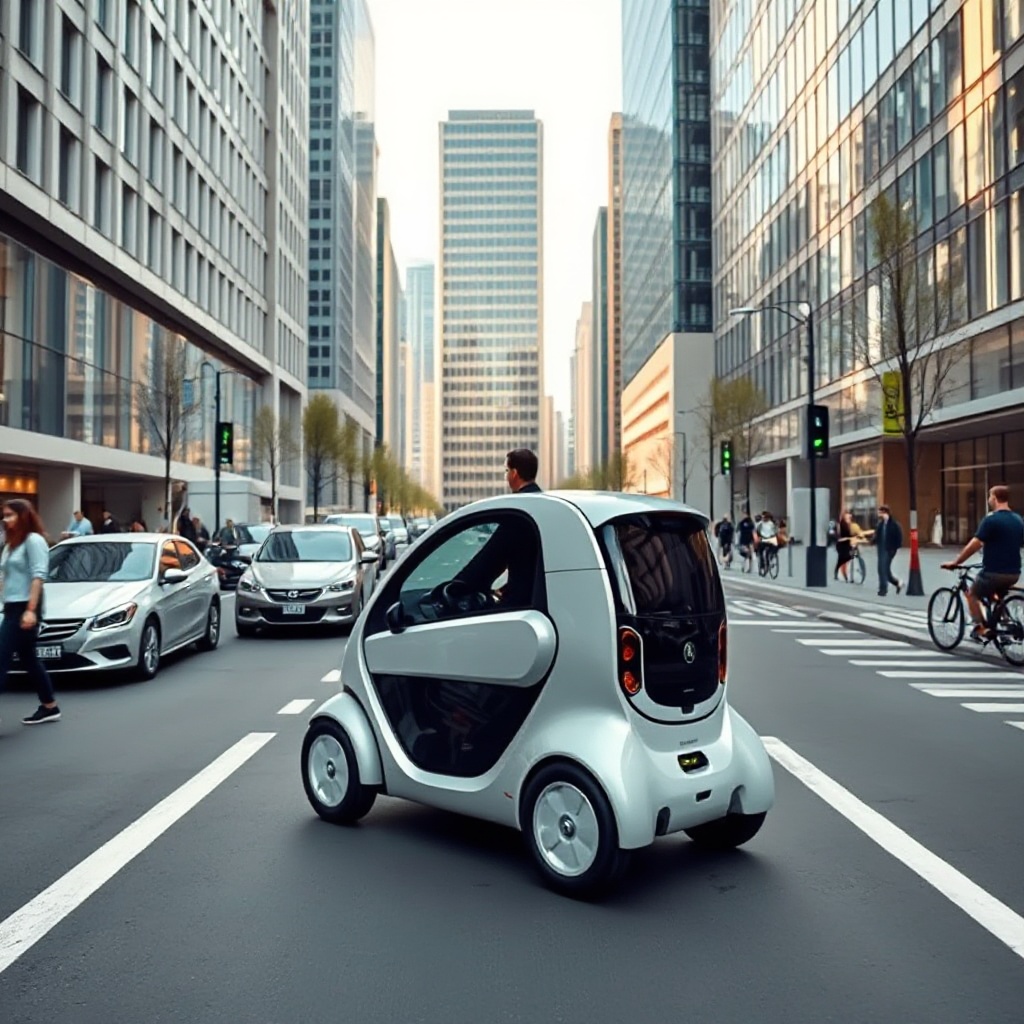
Micro-EVs offer efficient urban mobility with less energy use, fewer minerals, and lower costs—a $28.77B market by 2034 addressing congestion and pollution challenges.

Drivetech Partners
As urban centers grow and struggle with traffic congestion, air pollution, and limited space, micro-electric vehicles (micro-EVs) are emerging as a compelling alternative to bulky cars and SUVs. These compact, energy-efficient vehicles consume fewer resources throughout their lifecycle while addressing critical urban mobility challenges, from congestion to accessibility and environmental impact.
Key Takeaways
The global micro-EV market is projected to reach $28.77 billion by 2034, growing at a CAGR of 12.2% from $10.21 billion in 2025
Micro-EVs consume up to 20% less energy than larger electric vehicles while requiring 18-25% fewer critical minerals
Smaller electric vehicles provide significant safety benefits for pedestrians, as increasing vehicle mass by 300kg raises fatal injury risk for vulnerable road users by 30%
Urban centers in China, India, and Europe will account for 60% of micro-EV sales by 2030, driven by urbanization and regulatory incentives
These vehicles offer lower upfront and operating costs, making zero-emission transportation more accessible to broader populations
The Rise of Micro-EVs: Market Trends and Growth Projections
Micro-EVs represent a rapidly expanding segment of sustainable transportation. The global market, valued at $10.21 billion in 2025, is projected to reach an impressive $28.77 billion by 2034, achieving a compound annual growth rate (CAGR) of 12.2%. This remarkable growth reflects increasing recognition of the practical advantages these vehicles offer in dense urban environments.
The Asia-Pacific region currently leads global adoption, fueled by rapid urbanization and supportive regulatory frameworks. By 2030, urban centers in China, India, and Europe will account for approximately 60% of all micro-EV sales worldwide. This geographic concentration highlights how these vehicles align with the needs of densely populated cities facing critical mobility challenges.
Key market segments driving this growth include electric micro cars, compact city cars, and low-speed electric vehicles (LSEVs) such as neighborhood electric vehicles (NEVs). Particularly noteworthy is the surge in electric two-wheelers and three-wheelers, which already represent over 30% of sales in leading markets - a clear indicator of shifting consumer preferences toward more efficient urban transport options.

Environmental Advantages: Energy Efficiency and Resource Conservation
One of the most compelling arguments for micro-EVs is their superior energy efficiency. These smaller vehicles consume up to 20% less energy than larger electric models like SUVs. This efficiency directly translates to reduced urban energy demand and less strain on charging infrastructure - a crucial consideration as cities plan for widespread electrification.
Beyond energy consumption, micro-EVs offer significant advantages in resource conservation. By requiring 18-25% less critical minerals like lithium and cobalt for battery production, these vehicles help alleviate supply chain pressures while reducing lifecycle emissions associated with material extraction and processing.
The compact size of these vehicles means they require fewer materials throughout their entire lifecycle. This translates to lower manufacturing emissions during production and reduced operational environmental impact during use. Looking ahead to 2050, prioritizing micro-EVs could provide up to a 20% reduction in global mineral demand for batteries while contributing to substantial decreases in urban transport CO₂ emissions.
Urban Congestion Solutions and Mobility Integration
Urban congestion presents one of the most persistent challenges for growing cities worldwide. Micro-EVs address this problem through enhanced maneuverability and compactness, allowing for easier navigation through traffic and fitting into smaller parking spaces that would be inaccessible to larger vehicles.

Cities across the globe are implementing policy measures to encourage the adoption of compact, cleaner transportation options. These include restrictions on large vehicles in city centers, congestion charges, and the establishment of low-emission zones - all of which create favorable conditions for micro-EV adoption.
Micromobility solutions such as e-scooters, e-bikes, and electric mopeds play a critical role in addressing short urban trips and last-mile transit needs. Infrastructure improvements, including dedicated lanes and charging stations, are expanding the practical applications of these vehicles. The integration of micro-EVs with shared mobility fleets, public transit connections, and last-mile delivery services is positioning them as central components of modern, efficient urban transport systems.
Safety Benefits and Human-Centered Urban Design
The safety advantages of smaller vehicles extend beyond their occupants to protect the most vulnerable road users. Research shows that smaller vehicles pose less danger to pedestrians and cyclists - increasing a vehicle's mass by just 300kg raises the fatal injury risk for vulnerable road users by 30%. Large vehicles like SUVs and pickups can increase fatal pedestrian accident risk by as much as 45% due to their higher mass and front-end profiles.
Micro-EVs fit more naturally into people-centered urban environments where street design prioritizes non-motorized transportation. Their smaller footprint and lower speed capabilities create less intimidating streetscapes and reduce hazards from oversized vehicles. This alignment supports the transition to more livable, walkable cities with enhanced public spaces and reduced traffic danger.
Supporting the shift to micro-EVs complements broader urban design efforts aimed at creating cities where people, rather than vehicles, take precedence. This human-scale approach to transportation planning creates safer streets while improving quality of life for all residents.
Democratizing Zero-Emission Transport: Affordability and Access
One of the most significant advantages of micro-EVs is their economic accessibility. These vehicles typically offer lower upfront and operating costs compared to traditional vehicles, primarily due to reduced energy consumption and simpler maintenance requirements. This cost advantage makes zero-emission transport more accessible to broader urban populations who might otherwise be priced out of electric vehicle ownership.
As battery technology advances and prices continue to decline, the affordability of micro-EVs will further improve. Current challenges are being addressed through ongoing research and development and partnerships with governments for charging infrastructure expansion, which will help overcome remaining adoption barriers.
Beyond direct cost savings, compact EVs reduce parking demand and enable mobility in previously underserved areas. This supports more equitable transportation systems by extending the benefits of clean, efficient mobility to communities that have historically had limited transportation options.
Policy Drivers and Government Incentives
Government incentives play a crucial role in accelerating market adoption of micro-EVs. These include financial support mechanisms such as subsidies and tax breaks, as well as regulatory frameworks like low-emission zones. Such policies are particularly effective in regions that prioritize air quality improvements and have ambitious climate targets.
The combination of increasing urbanization and worsening traffic congestion is driving demand for space-efficient, low-emission transport options. Over 50% of micro-EV adoption is linked to cities with strict congestion and emission controls, demonstrating the powerful influence of policy on consumer transportation choices.
Shifting from larger EVs to micro-EVs and lightweight vehicles represents an essential strategy for meeting city-level climate targets and supporting global emission reduction goals. This approach aligns with United Nations frameworks and local urban planning initiatives focused on sustainable transportation, improved air quality, and enhanced public health outcomes.
Real-World Applications and Use Cases
The micro-EV category encompasses a diverse range of vehicle types and applications. Products include electric micro cars, compact city cars, neighborhood electric vehicles (NEVs), electric mopeds, shared e-bikes, and electric scooters - each serving different mobility needs in the urban environment.
These vehicles are finding practical applications across multiple sectors, including:
Last-mile deliveries for urban logistics
Shared mobility fleets for on-demand transportation
Urban public sector vehicles (street maintenance, security patrols)
Personal commuting within low-emission zones
Emerging ecosystems are enabling seamless connectivity between public transit and micro-EV/hybrid mobility through contactless payment systems and shared vehicle platforms. This integration creates a more cohesive transportation network that addresses the diverse mobility needs of urban residents while reducing reliance on private car ownership.
Climate Impact and Future Outlook
Micro-EVs make a direct contribution to climate goals by providing more efficient and resource-light alternatives to large electric vehicles. By focusing on right-sized vehicles for urban use, cities can achieve transportation decarbonization more rapidly and with lower resource intensity than would be possible with a wholesale shift to standard-sized electric vehicles.
Looking ahead, future innovations will likely focus on improved battery technology, lightweight materials, and enhanced integration with smart city infrastructure. These advancements will further increase the effectiveness of micro-EVs in addressing urban mobility challenges while minimizing environmental impact.
The combination of environmental benefits, practical urban advantages, and improving economics positions micro-EVs as a cornerstone of sustainable urban mobility systems. As cities continue to grow and face increasing transportation challenges, these compact, efficient vehicles offer a solution that balances immediate practicality with long-term sustainability goals.
Sources
Grand View Research - Micro Electric Vehicle Market Size | Industry Report, 2030
Precedence Research - Micro Electric Vehicle Market Size to Hit USD 28.77 Bn by 2034
Accio - Affordable Micro Cars Trend: 2025 Market Growth & Urban Solutions
World Resources Institute - For Electric Vehicles, Smaller Is Better
BNEF - Electric Vehicle Outlook
IEA - Global EV Outlook 2025
O-CITY - Mobility Trends 2025: What's Next in Urban Mobility
IDTechEx - Micro EVs 2025-2045: Electric Two-Wheelers, Three-Wheelers and Microcars






